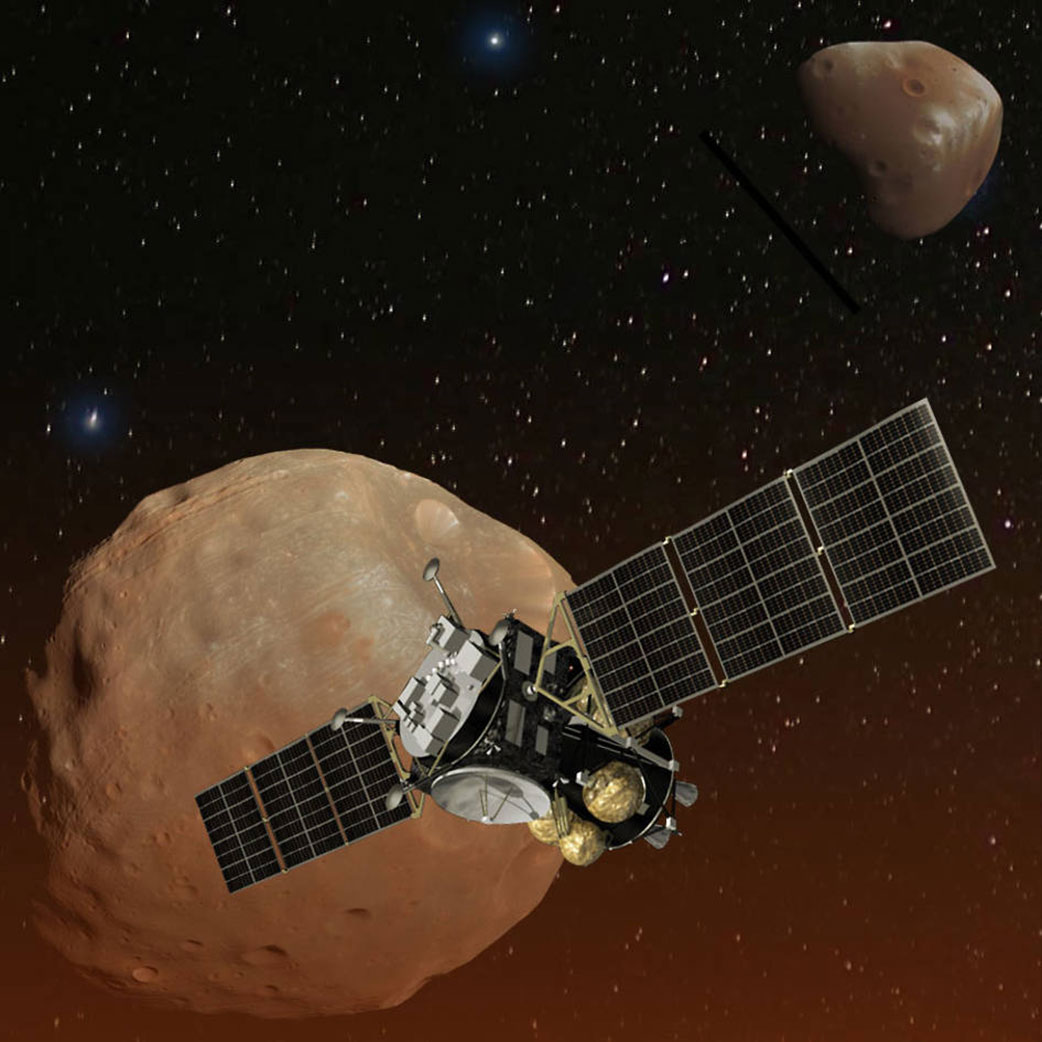
Japan has another sample-return mission in the works, this one to a mysterious moon of Mars.
The Martian Moon Exploration (MMX) mission, which aims to haul pieces of the Mars moon Phobos to Earth, has officially become a Japan Aerospace Exploration Agency (JAXA) project, mission team members announced on Thursday (Feb. 20).
"The mission was previously in the pre-project phase, where the focus was on research and analysis, such as simulating landings to improve spacecraft design," MMX team members wrote in a blog post. "The focus will now move onto the development of mission hardware and software."
Related: 7 biggest mysteries of Mars
If all goes according to plan, the MMX spacecraft will launch in 2024 and enter orbit around the Red Planet in 2025. The probe will visit both of Mars' moons, Phobos and Deimos, and will touch down on the former for a few hours to snag samples. MMX will then deliver this pristine Phobos material to Earth in 2029, where scientists can scrutinize it in detail.
Such study could reveal key insights about the Red Planet system and our solar system more broadly, JAXA officials have said. For example, the origin of Phobos and Deimos is a subject of debate; some researchers think they're captured asteroids, whereas others have posited that they're made of material blasted off Mars by a long-ago giant impact (or impacts).
"The Martian moons are expected to have accumulated sediment that was ejected from Mars over billions of years," JAXA officials wrote in a mission description.
Get the Space.com Newsletter
Breaking space news, the latest updates on rocket launches, skywatching events and more!
"Observing the moons will therefore provide information on the evolution of the Martian surface," they added. "Moreover, if the moons were formed during a collision between Mars and gigantic asteroids, the moon material will reveal the original conditions on Mars during this early time, offering insights into the planet's formation and its young environment. Alternatively, if the moons are captured asteroids, their composition will help clarify the transport process of volatile components (such as water) needed for habitability."
JAXA already has considerable experience in sample-return missions to small bodies. In 2010, for example, the agency's Hayabusa mission delivered to Earth tiny bits of the stony asteroid Itokawa. And the Hayabusa2 probe recently snagged pieces of the carbon-rich asteroid Ryugu, which are scheduled to arrive here in December.
Planetary scientists could get their hands on pristine samples from the Martian surface in a decade or so, by the way, if things go according to plan. NASA's life-hunting 2020 Mars rover, which is scheduled to launch this July, will collect and cache samples as part of its varied work on the Red Planet. NASA and the European Space Agency will work together to get this material home, which could happen as early as 2031.
- JAXA: The Japan Aerospace Exploration Agency
- Japan's Hayabusa2 asteroid Ryugu sample-return mission in pictures
- A Mars sample-return mission is coming. Scientists want the public to know what to expect.
Mike Wall is the author of "Out There" (Grand Central Publishing, 2018; illustrated by Karl Tate), a book about the search for alien life, . Follow him on Twitter @michaeldwall. Follow us on Twitter @Spacedotcom or Facebook.
OFFER: Save at least 56% with our latest magazine deal!
All About Space magazine takes you on an awe-inspiring journey through our solar system and beyond, from the amazing technology and spacecraft that enables humanity to venture into orbit, to the complexities of space science.
Join our Space Forums to keep talking space on the latest missions, night sky and more! And if you have a news tip, correction or comment, let us know at: community@space.com.

Michael Wall is a Senior Space Writer with Space.com and joined the team in 2010. He primarily covers exoplanets, spaceflight and military space, but has been known to dabble in the space art beat. His book about the search for alien life, "Out There," was published on Nov. 13, 2018. Before becoming a science writer, Michael worked as a herpetologist and wildlife biologist. He has a Ph.D. in evolutionary biology from the University of Sydney, Australia, a bachelor's degree from the University of Arizona, and a graduate certificate in science writing from the University of California, Santa Cruz. To find out what his latest project is, you can follow Michael on Twitter.










